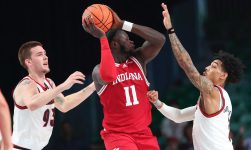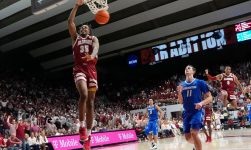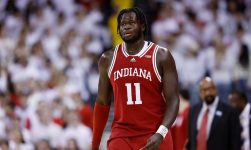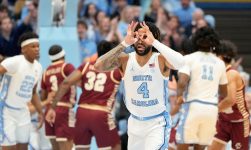What’s the first thing that jumps to mind when you hear the name Carmelo Anthony?
For Nuggets fans, sure, it’s understandably Melo in a baby-blue Denver uni in the first part of his NBA career. (Given how lovely things currently are in the Rockies, those fans’ fondness of Anthony rejuvenating the franchise in the 2000s is probably greater on this day than ever before. His NBA retirement announcement on Monday was well-timed in that respect.)
And for the irascible yet incurable Knicks fans, who back that franchise no matter how terrible their existence can sometimes be, I suppose there are some good memories tied to Anthony’s time there — even if it was complicated by his poor handling of the Linsanity phenomenon. Many Knicks fans aren’t quick to forget that Anthony pushed the team to only one conference semifinals appearance, either.
Anthony suited up for six NBA franchises in 19 seasons. In the winter of his career, he petered out in Oklahoma City, Houston, Portland and Los Angeles. For as fun as he was in Denver and as much buzz as his Knicks signing brought to Manhattan (and the NBA) at the time, I think it’s fair to say none of those teams will be what he’s most remembered for. It’s not his outstanding Olympics run either, though that’s a major part of his basketball legacy.
Melo is a 10-time All-Star, two-time All-NBA Second Team (and four-time Third Team) honoree. In what probably landed as shocking news to many people on Monday, the man also stands proudly at No. 9 on the NBA’s all-time scoring list, ahead of Moses Malone, Elvin Hayes, Hakeem Olajuwon and Kevin Durant. He won three Olympic gold medals — the first player to achieve the feat. His career was a substantial one, a 19-year professional stride that will put him in the Naismith Memorial Hall of Fame later this decade.
Yet, 20 years on, Melo is most closely tied to New York — but not the city. It’s the school in the center of the state, the place that is the start of his Hall of Fame journey. Someone says “Carmelo Anthony” and most people think: Syracuse.
Some Knicks fans will recall Anthony’s 62 at the Garden, but quick question: Can you even name the year that happened or the opponent it came against? I bet you know the year Anthony won a national title, though. And you know the team he did it against, too.
Anthony never won an NBA championship, never made an NBA Finals and only made it to the conference finals once. I don’t fault him for that, and I don’t think it depletes a pretty good 20-year run of individual sometimes-greatness. The reason Anthony is a borderline lock to be a first ballot Naismith Memorial Hall of Famer isn’t his NBA achievements. It’s what he did for 35 games in a Syracuse uniform in 2002 and 2003 that gets him to the front of the line.
Ironically, his team shortcomings at the NBA level make his college legacy all the bigger and more long-lasting and more symbolic to his reputation as a great American basketball talent. Anthony’s move to the Knicks in 2011 was such a big deal in no small part because he played in-state for the other basketball team that wears orange.
It’s because of his national championship at Syracuse that Anthony’s reputation remained in relatively high esteem, even as his NBA career was subject to criticism.
His debut at Madison Square Garden didn’t happen as an NBA player, but in college. His debut, at that. Syracuse played Memphis. Dick Vitale was on the call. I remember it well, almost 20 years later. Syracuse lost, but Anthony exploded for 27 points and 11 rebounds, his amazing run initiated by a breakaway dunk in the first two minutes that prompted Vitale to exclaim to the nation why this “diaper dandy” at Syracuse was going to be the best freshman in program history.
He was right.
I had the fortune of watching Anthony play a few times in person while he was at Syracuse. His recruitment was highly buzzed about; he was the best player in his class to choose to play college that year. One time, while visiting friends at Syracuse, I happened to walk beside Anthony on campus for a few minutes. I still remember how huge he looked in person while strutting amongst his fellow students. He held a flip phone to his ear, very possibly pantomiming conversation just so he could get from one place to the next, while students scurrying past flashed excited looks, giddy smiles and quick high-fives as they made their brush with greatness. (Smartphones had obviously not yet been invented.)
He was a rock star on that campus.
Unusual is the player who gets their number retired despite playing only one season. If ever a player warranted it, it was Melo at Cuse. (That happened in 2013.) He was the national freshman of the year, the Final Four Most Outstanding Player and a consensus Second Team All-American. The only reason he wasn’t a First Team selection was due to the extreme rarity that honor was appended to freshmen; Anthony’s season basically changed the tenor of voters in the years after he left college.
Anthony went on to average 22.2 points and 10.0 rebounds in 2002-03, authoring one of the quintessential one-and-done seasons in college hoops history. To this day, he’s one of only a few freshmen in history to be the best player on a championship-winning team. He did it at basketball-loving Syracuse, giving the program its only title. They’ll play college hoops at SU until the end of civilization, and I don’t know if they’ll ever win another NCAA Tournament — but they got one and they got it because of Carmelo Anthony.
It changed his image for the better forever, it legitimized Syracuse basketball and it gave us Jim Boeheim in a ridiculous, fuzzy orange cowboy hat.
He elevated Boeheim’s legacy in the process, too. Boeheim’s Hall of Fame résumé would have felt incomplete without at least one national title. That ’02-03 season had a special juju to it, and by that I mean: Not many people expected Syracuse to win the title, but the way it happened seemed like it should happen as it unfolded. It wasn’t a surprise, and Syracuse was better than a No. 3 seed.
It takes a special player to change that dynamic, and that’s exactly what an 18-year-old Carmelo was.
Syracuse was already a national program when Anthony got there, but his superb frosh campaign lifted Syracuse as a brand all the more. Anthony’s play was one of the biggest stories in basketball in 2003. His NBA stock skyrocketed; the term “one-and-done” became more and more commonplace after he vaulted to the NBA.
Today, a high-level practice facility bears his name on Syracuse’s campus. He’s among the most beloved figures in that city’s history.
Not every NCAA Tournament is remembered primarily for its national champion; in some years that’s just part of a bigger story. Twenty years post, it feels like the ’03 tournament is all about what Syracuse did. It started with Boeheim but it happened because of Melo — who we called Carmelo back then. Fellow freshman Gerry McNamara was crucial, as was Hakim Warrick and his game-saving block against Kansas. It was a culmination for a program that was often close but never the victor.
Anthony was such a gifted scorer, he was Hall of Fame-bound regardless if he played college basketball or not. But as a basketball community takes a little time to reflect on Melo’s varied career, let’s acknowledge that he’s the semi-rare example of a Hall of Fame competitor whose time in college was crucial, if not prominently defining, to his legacy. He’s not the first, and he won’t be the last, but there might not be a bigger example of someone whose career benefited in a bigger way — in a shorter period of time — than Melo’s reputation bump because of his freshman year of glory and dominance at Cuse.
Anthony’s career is in some ways analogous to some of the greatest bands of all time, groups who never escape the shadow of their first record. For Anthony, too, the debut was the high point. The thing that made him immediately famous is what he’ll be most remembered for. It doesn’t dilute what came after, it only reinforces how incredible the start of all this was.






